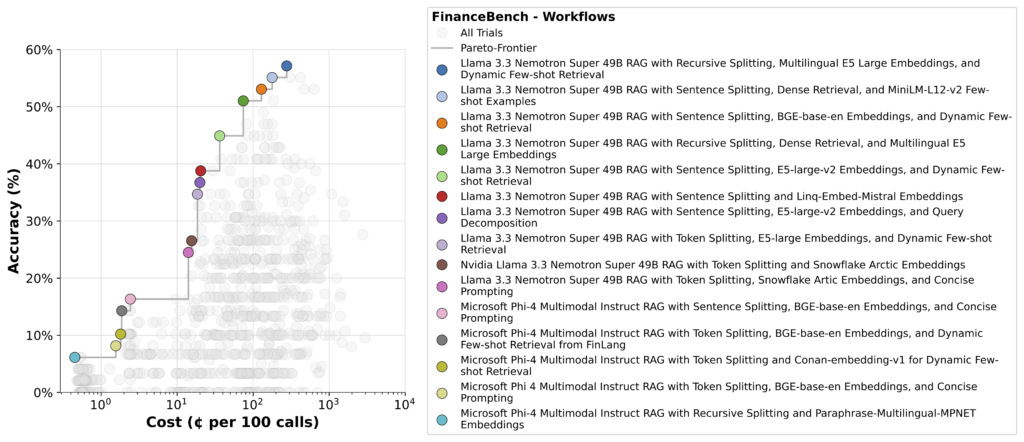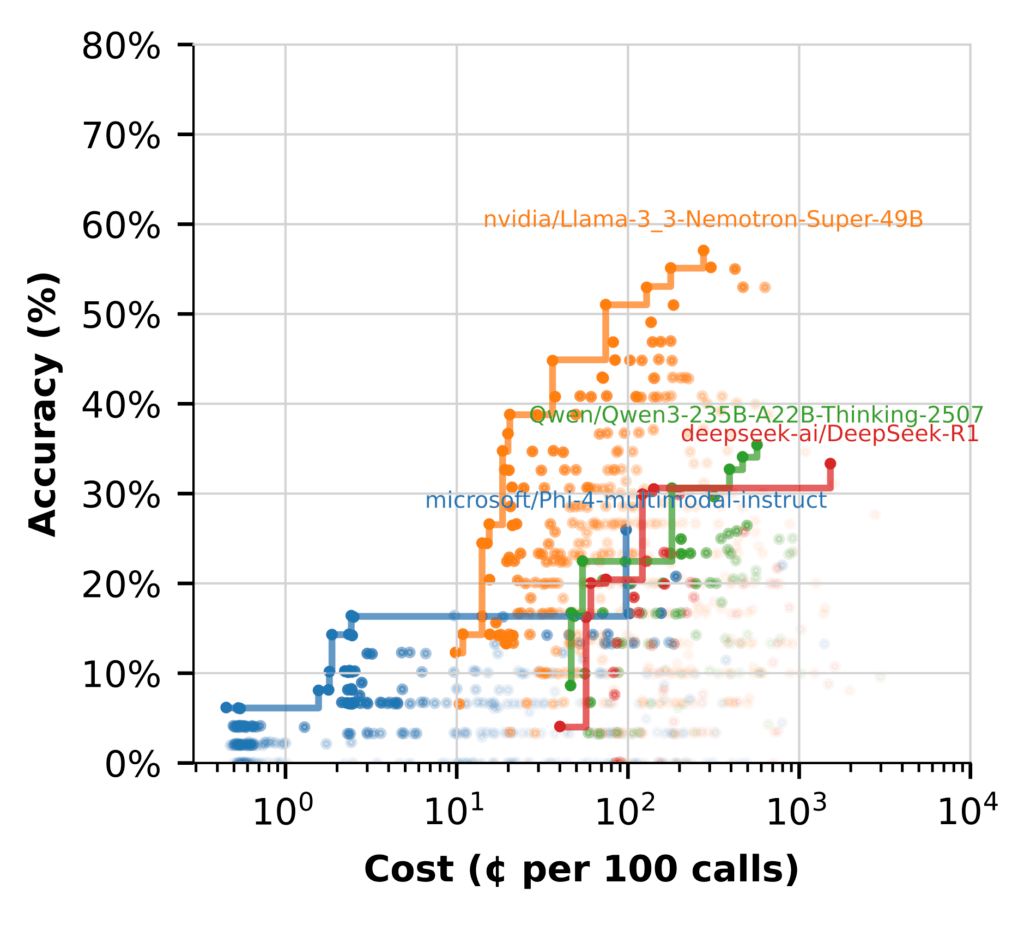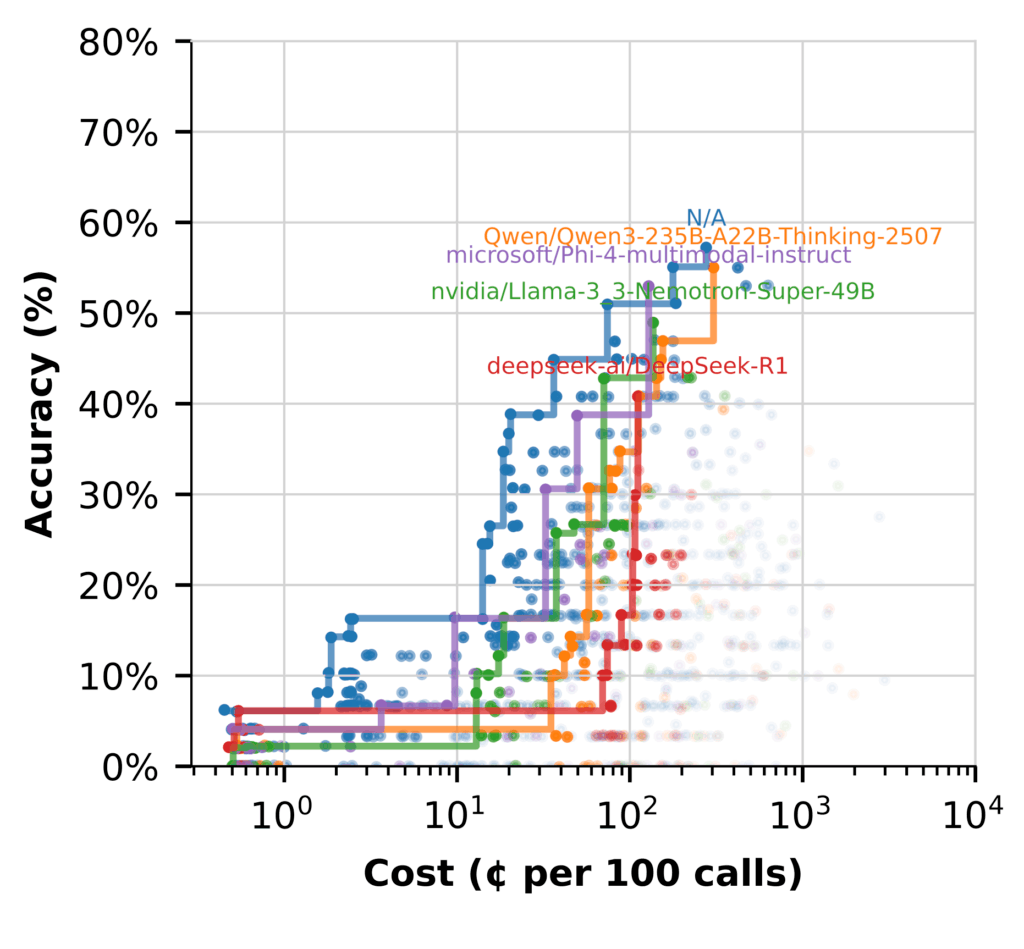Each week, new fashions are launched, together with dozens of benchmarks. However what does that imply for a practitioner deciding which mannequin to make use of? How ought to they method assessing the standard of a newly launched mannequin? And the way do benchmarked capabilities like reasoning translate into real-world worth?
On this submit, we’ll consider the newly launched NVIDIA Llama Nemotron Tremendous 49B 1.5 mannequin. We use syftr, our generative AI workflow exploration and analysis framework, to floor the evaluation in an actual enterprise downside and discover the tradeoffs of a multi-objective evaluation.
After inspecting greater than a thousand workflows, we provide actionable steerage on the use circumstances the place the mannequin shines.
The variety of parameters depend, however they’re not all the things
It needs to be no shock that parameter depend drives a lot of the price of serving LLMs. Weights have to be loaded into reminiscence, and key-value (KV) matrices cached. Larger fashions usually carry out higher — frontier fashions are nearly all the time large. GPU developments have been foundational to AI’s rise by enabling these more and more giant fashions.
However scale alone doesn’t assure efficiency.
Newer generations of fashions usually outperform their bigger predecessors, even on the similar parameter depend. The Nemotron fashions from NVIDIA are instance. The fashions construct on present open fashions, , pruning pointless parameters, and distilling new capabilities.
Meaning a smaller Nemotron mannequin can usually outperform its bigger predecessor throughout a number of dimensions: quicker inference, decrease reminiscence use, and stronger reasoning.
We needed to quantify these tradeoffs — particularly in opposition to among the largest fashions within the present era.
How rather more correct? How rather more environment friendly? So, we loaded them onto our cluster and started working.
How we assessed accuracy and price
Step 1: Determine the issue
With fashions in hand, we would have liked a real-world problem. One which checks reasoning, comprehension, and efficiency inside an agentic AI move.
Image a junior monetary analyst making an attempt to ramp up on an organization. They need to be capable of reply questions like: “Does Boeing have an enhancing gross margin profile as of FY2022?”
However additionally they want to clarify the relevance of that metric: “If gross margin shouldn’t be a helpful metric, clarify why.”
To check our fashions, we’ll assign it the duty of synthesizing information delivered via an agentic AI move after which measure their means to effectively ship an correct reply.
To reply each sorts of questions appropriately, the fashions must:
- Pull information from a number of monetary paperwork (equivalent to annual and quarterly reviews)
- Evaluate and interpret figures throughout time intervals
- Synthesize a proof grounded in context
FinanceBench benchmark is designed for precisely one of these process. It pairs filings with expert-validated Q&A, making it a robust proxy for actual enterprise workflows. That’s the testbed we used.
Step 2: Fashions to workflows
To check in a context like this, you should construct and perceive the total workflow — not simply the immediate — so you may feed the best context into the mannequin.
And you need to do that each time you consider a brand new mannequin–workflow pair.
With syftr, we’re in a position to run tons of of workflows throughout totally different fashions, shortly surfacing tradeoffs. The result’s a set of Pareto-optimal flows just like the one proven beneath.

Within the decrease left, you’ll see easy pipelines utilizing one other mannequin because the synthesizing LLM. These are cheap to run, however their accuracy is poor.
Within the higher proper are probably the most correct — however extra costly since these usually depend on agentic methods that break down the query, make a number of LLM calls, and analyze every chunk independently. This is the reason reasoning requires environment friendly computing and optimizations to maintain inference prices in examine.
Nemotron exhibits up strongly right here, holding its personal throughout the remaining Pareto frontier.
Step 3: Deep dive
To raised perceive mannequin efficiency, we grouped workflows by the LLM used at every step and plotted the Pareto frontier for every.

The efficiency hole is obvious. Most fashions battle to get wherever close to Nemotron’s efficiency. Some have bother producing cheap solutions with out heavy context engineering. Even then, it stays much less correct and dearer than bigger fashions.
However once we swap to utilizing the LLM for (Hypothetical Doc Embeddings) HyDE, the story modifications. (Flows marked N/A don’t embody HyDE.)

Right here, a number of fashions carry out properly, with affordability whereas delivering excessive‑accuracy flows.
Key takeaways:
- Nemotron shines in synthesis, producing excessive‑constancy solutions with out added price
- Utilizing different fashions that excel at HyDE frees Nemotron to deal with high-value reasoning
- Hybrid flows are probably the most environment friendly setup, utilizing every mannequin the place it performs finest
Optimizing for worth, not simply dimension
When evaluating new fashions, success isn’t nearly accuracy. It’s about discovering the best stability of high quality, price, and match in your workflow. Measuring latency, effectivity, and total impression helps make sure you’re getting actual worth
NVIDIA Nemotron fashions are constructed with this in thoughts. They’re designed not just for energy, however for sensible efficiency that helps groups drive impression with out runaway prices.
Pair that with a structured, Syftr-guided analysis course of, and also you’ve bought a repeatable approach to keep forward of mannequin churn whereas protecting compute and finances in examine.
To discover syftr additional, take a look at the GitHub repository.


Leave a Reply